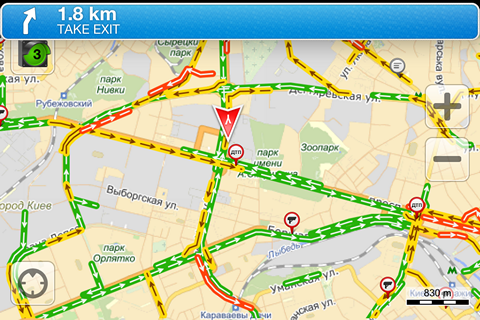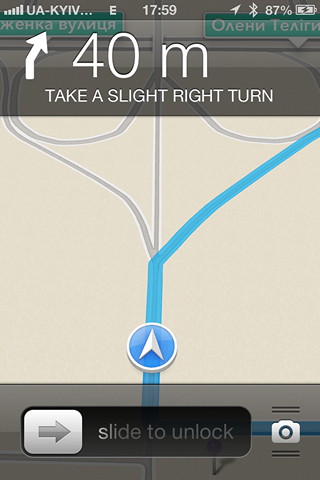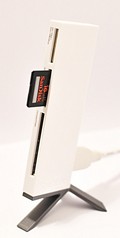iPhone 5 price compared with iPhone 4S year ago (about 5% growth because of Norwegian Krone exchange rate changes).
| iPhone 4S (2011) | iPhone 5 (2012) | |
| 16 GB | 4890 NOK | 5190 NOK |
| 32 GB | 5790 NOK | 6090 NOK |
| 64 GB | 6690 NOK | 6990 NOK |
iPhone 5 price compared with iPhone 4S year ago (about 5% growth because of Norwegian Krone exchange rate changes).
| iPhone 4S (2011) | iPhone 5 (2012) | |
| 16 GB | 4890 NOK | 5190 NOK |
| 32 GB | 5790 NOK | 6090 NOK |
| 64 GB | 6690 NOK | 6990 NOK |
NAS Synology DS-209+ with External Drive Zalman ZM-HE350 U3E (with Seagate ST2000DL003 5900RPM). Compare speed of external connected disk using USB 2.0 and eSATA.
| Read | Write | |
| USB 2.0 | 24 MB/s | 22 MB/s |
| eSATA | 125MB/s | 100 MB/s |
iOS 6 new maps navigation working on background of another application (i.e. Yandex maps). With both voice and text notifications:

See also how it work on locked screen:

Some screenshots of new iOS map application. No traffic info seen on map yet. Navigation is here, but Ukrainian streets names reading is absolutely terrible. And mistake in name of Ukrainian capital (Kyiv) is something very unexpected from Apple product.
To get understanding of why cheap USB Flash are cheap and some expensive are expensive. Let’s compare two 32GB flash drives from SanDisk. Cheap one is SanDisk Cruzer 32GB SDCZ36-032G. Expensive one is SanDisk Extreme USB 3.0 SDCZ80-032G.
Speed test done with CrystalDiskMark 3.0.1
Yet another SD cards to test:
Sandisk MicroSD 16GB Ultra
Trnscend SD 32GB Class 10
* usual notebook embeded SDHC cardreader was used (without Sandisk proprietary 30MB/s or standard UHS-1 mode support)
tested with CrystalMark 3.0.1
Passmark performance test yet another mobile performance benchmark. It show not only CPU or GPU speed, but also Memory speed and “HDD” speed.
Results for iOS devices:
http://www.iphonebenchmark.net
Result for Android:
Reading some old posts:
SanDisk Extreme 30 MB/s SD Card
SanDisk SDDR-199
SD Cards test with SDDR-1999
Now I know what was wrong with 30MB/s SanDisk Extreme SD cards. 30 MB/s was not standard bus speed for SD. So it is seems like only (one?) card reader from SanDisk was supporting that speed. And it was not a good idea to buy 30MB/s cards. Actually theoretical maximum speed for normal and high speed SD cards was 12.5 MB/s and 25MB/s (read as 10MB/s and 20 MB/s in real life). And, by the way, USB 2.0 (480 Mbit/s) has reallife speed for cardreader/hdd/etc ~ 30 MB/s at maximum.
New SD card standards are UHS-1 with 50 MB/s and 100 MB/s (read as 45 MB/s and 90 MB/s) and UHS-II with 156 MB/s and 312 MB/s.
So now some examples of UHS-1 standard in use:
SanDisk ImageMate SDDR-289 (USB 3.0)

USB 2.0 is not enough to get 45+ MB/s that is why UHS-* cardreaders must be USB 3.0 or other modern high speed interface.
Card formated to exFAT. Cardreaders setting “optimized for performance” in Windows 7.
| USB | Reader | Card | Read MB/s | Write MB/s |
|---|---|---|---|---|
| USB 3.0 | UHS-1 | UHS-1 45MB/s | 39MB/s | 24MB/s |
| USB 2.0 | UHS-1 | UHS-1 45MB/s | 26MB/s | 16MB/s |
| USB 2.0 | non UHS-1 | UHS-1 45MB/s | 18MB/s | 14MB/s |
Card Formatted to FAT32 by SD Formatter 3.1
| USB | Reader | Card | Read MB/s | Write MB/s |
|---|---|---|---|---|
| USB 3.0 | UHS-1 | UHS-1 45MB/s | 36MB/s | 32MB/s |
| USB 2.0 | UHS-1 | UHS-1 45MB/s | 25MB/s | 20MB/s |
| USB 2.0 | non UHS-1 | UHS-1 45MB/s | 18MB/s | 17MB/s |
speed tested with Flash Memory Toolkit “File Transfer (5MB)”